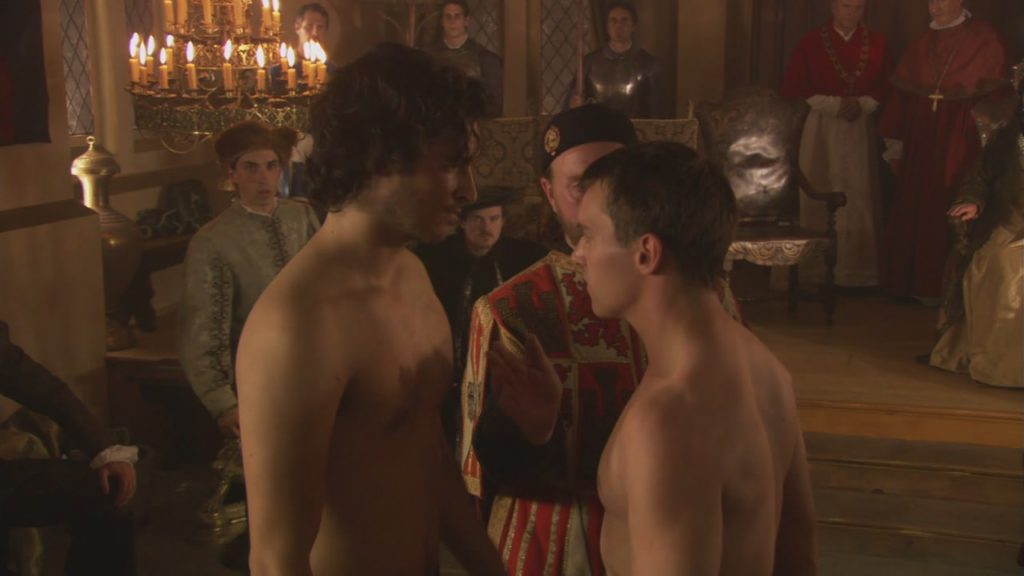The history of wrestling stretches into ancient times. It was first described in the Greek literature, including in Homer’s legendary literary works such as the Iliad and the Odyssey. Greek wrestling was a popular form of martial art, and it was featured as a sport since the eighteenth Olympiad in 704 BC. After the country’s subjugation by the Romans, Greek wrestling was highly influenced by Roman culture during the period of the Roman Empire.
Men wrestling, detail of an ancient Greek cup
In the Middle Ages and in the Renaissance era, wrestling was practiced by both the nobility and the lower classes. The modern history of wrestling commenced with a rise of its popularity in the 19th century, and nowadays it is a sport for the masses. During the Field of Cloth of Gold of 1520, there was a particularly remarkable wrestling match that happened sometime between the 7 and 24th of June 1520 between King Henry VIII of England and King François I of France.
The Field of Cloth of Gold took place near Calais between the monarchs of France and England in an attempt to preserve the peace established by the Treaty of London of 1518 (a non-aggression pact between the major European nations), and to create an alliance against Charles V, who had been elected Holy Roman Emperor in 1519. In reality, this summit was a throw-down of riches and power in the guise of a constant competition between Henry and François.
At the time, François needed Henry more than his rival needed him. After Charles von Habsburg had become the most powerful man in Christendom, France was encircled by the Habsburg territory. Given the Spanish wealth and the might of their armies, François felt that his country could be in peril, so he was seeking allies against the emperor. To change the balance of power in Europe and to protect France from Spain, François needed to have Henry as his ally.
The two kings and their courts spent three weeks of partying. They were involved in jousting, games, and lavish festivities; tents of gold fabric populated the area. According to contemporary sources, 4,100 animals were slaughtered over the course of the meeting. Malmsey and claret flowed from drinking fountains, and into the mouths of the French and the English. The monarchs exchanged gifts and declarations of their “undying love and loyalty” to each other. In the midst of all that spectacular entertainment, Henry once beat François in an archery contest, and as the wine and success went to his head, he challenged his Valois rival to a wrestling match.
A French tapestry of the meeting of Kings Henry VIII and François I, circa 1520, Tournai
At first, François hesitated. He was concerned that if he won the contest, his victory over the narcissistic and spoiled Henry would eradicate all his attempts to make the man his ally. Nevertheless, Henry seems to have been insistent, and François, who was a man of chivalrous nature and high aspirations, finally consented to fight against his Tudor counterpart. François could be as inebriated as Henry was, and his kingly ego did not allow him to refuse the challenge.
Historical accounts of the fight itself are scarce. The two kings went in search of a suitable place for a match. Imagine that they were both attired in their magnificent outfits! Both men were renowned for their great height. Henry excelled in Cornish wrestling (a style established in Cornwall in South-West England), while François wrestled in gouren (a style of folk wrestling that was established in Brittany), or Breton wrestling. The main difference between these two styles was in the type of jacket used: the Breton jacket was tight, while the Cornish wrestler wore it loose. 
François and Henry before the fight, from the Showtime series ‘The Tudors’
We don’t know how exactly the fight took place. Most likely, the two courts assembled around their sovereigns, watching them fight and each of them cheering their own liege lord. Eventually, François outmaneuvered his counterpart and threw him to the ground. Outwardly, the King of England took his defeat calmly, but inside he must have been boiling with anger, and perhaps, Cardinal Wolsey had to persuade his temperamental king not to destroy the Anglo-French friendship, just as it is shown in one of the episodes in the Showtime series ‘The Tudors’.
Without a shadow of a doubt, Henry’s egotistical soul could not forget and forgive his failure to beat François. The French ruler’s victory became a harbinger of Henry’s future alliance with the emperor. Within two years of the summit, Henry and Charles would join forces and declare war on France, and François would be captured at Pavia in 1525. Nonetheless, years later, Henry would align with François again in 1527 when they made with the Treaty of Amiens against the emperor. Royal friendships and alliances are fickle, aren’t they?







